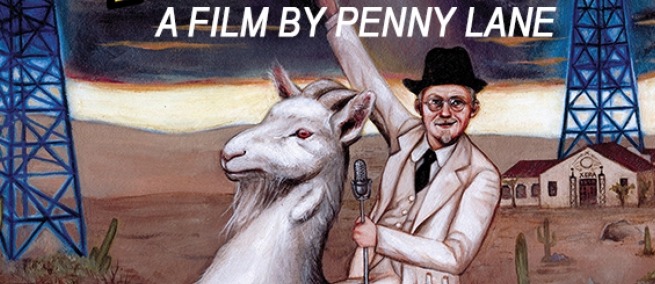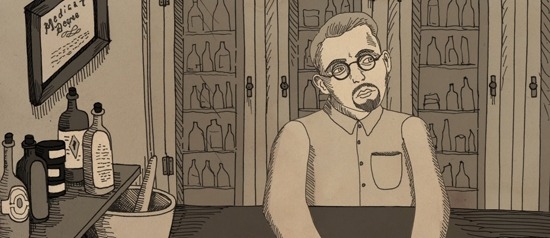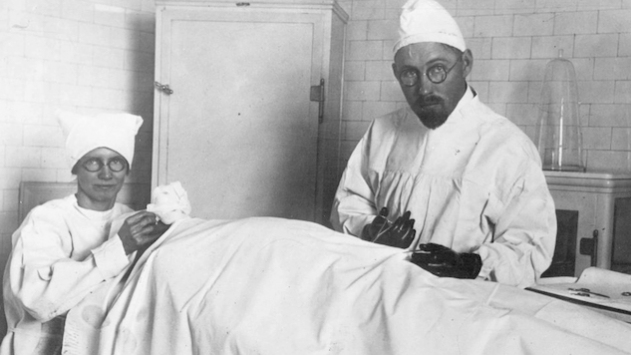
The Museum of the Moving Image will be screening Penny Lane’s new film NUTS! with the director herself in person on October 1, 2016. The film, a documentary verging on mockumentary, is about Dr. John Romulus Brinkley, a self-made man of the 1920s. He marketed a cure for impotence, which relied on goat-testicles. In January of 2016, Science & Film interviewed Lane before the film’s premiere at the Sundance Film Festival. An edited version of that interview is republished below.
Science & Film: NUTS! is having its world premiere at Sundance, who do you see as your audience?
Penny Lane: I see it in a couple of different ways. One audience is documentary lovers—people like me who go on Netflix and click on things that are interesting. There is a strongly skeptical message to the film. Essentially the film is extremely entertaining, and funny, and fun, and silly in some ways, but it’s also about what a quack doctor is and what pseudoscience is, and the kinds of critical skepticism I would hope more people would bring to bear on those things. It’s not like the film has an expert talking head sitting down explaining what pseudoscience is, but you can learn a lot about how to spot a quack in the wild by watching the film.
S&F: What inspired you to make this film?
PL: I was in a public library and there was a shelf of books that were recommended by the librarian. One of them was a book called Charlatan by Pope Brock and it’s a biography of Brinkley. Pope Brock is one of the interview subjects in my film, and his book is amazing. I was instantly hooked.
S&F: What science research went into making the film?
PL: I spoke with a woman who is a medical historian. I didn’t really know how out-of-the box the claims that Brinkley was making then were. Were the things he was saying obviously insane in 1917? Or were they considered plausible? What is the relationship between medical science as we know it today and where was it then? That’s the kind of stuff I had to understand to understand the story. And frankly, it was not seen as that crazy. Some people would have known that it was crazy, but that would have been a fairly scientifically literate population, and most people aren’t, including me. At the time, everyone was excited about hormones. They had just figured out what hormones were. The person who discovered insulin won the Nobel Prize in the early 1920s, so it was the new hot thing in medical science. Brinkley just did what all quacks do, which is to look at what’s in the headlines and then just say you’re doing it. So there are quacks today who say they’re doing gene targeted therapy—they’re not doing gene targeted therapy they’re selling snake oil, but they call it gene targeted therapy, because that’s what people read about in the newspaper. As far as my own scientific education goes, that’s the sort of thing I had to understand so I could position Brinkley better in the world.

S&F: Do you have any gauge as to how you think the scientific community will respond to the documentary?
PL: It’s hard to know—I’m definitely excited for the scientific community to see it. I’ve talked to a lot of doctors over the years, just people I know personally, and I think they get a kick out of it because it’s a very funny subject—it’s not threatening to anybody, it’s not as though it’s coming after you and your homeopathy or anything. The film’s subject is so ridiculous no one’s going to be turned off by it in that sense. But the film is really about how you differentiate between science and pseudoscience. For example, what is the difference– ethically–between someone who is a scientist who may be just wrong, someone who thinks they’ve figured something out and is incorrect, and someone who’s a con man? There’s actually a huge difference between those two kinds of people, and those are some of the things I hope people will learn. I hate saying “learn,” I don’t want to actively “learn” anything when I watch a movie, personally. I think it’s a really significant difference and I don’t think most people spend time differentiating those things in their mind—the difference between science that may be incorrect currently but is part of a progression toward understanding something real about the world, and people who are lying to you. There’s quite a big difference.
S&F: I’ve seen OUR NIXON twice and that film is so distinctive, does this film have any similarities?
PL: I would think that anyone who saw the two movies would think that some similarities exist. The protagonists are quite similar. They were both about highly intelligent people who were born in the early part of the twentieth century in America and through genius and determination rose to the top of whatever field they were in. Then, through their own hubris they fell in a spectacularly tragic way. You don’t need me to tell you that about Nixon. For Brinkley, he went down really, really badly and ultimately he brought himself down. I also really like these complicated subjects who are geniuses, and brilliant, and kind of amazing, but then also maybe evil. That’s an interesting person to think about–what makes someone like that tick in all their contradictions? There’s a way they both might believe their own bullshit but I’m not sure.
S&F: Did you use a lot of original footage for NUTS!?
PL: This movie started the same way as OUR NIXON—I’m very interested in archival research and historical footage, and doing that research brings me a lot of joy. To make OUR NIXON I had 4,000 hours of candid audio tape which allowed me to make those characters into characters. You couldn’t make the subjects characters from news clippings and the silent home movies–you needed that candid, day to day, conversation. To make NUTS! I didn’t have anything like that—I had lots of archival footage but it functions in the same way as those archival movies in OUR NIXON, they’re kind of opaque. You don’t get a character. What happened with NUTS! is I ended up scripting reenactments. More than half of the film is animated reenactments with actors voicing characters and scenes being played out—that’s how I decided to bring Brinkley to life in this film, so that’s a very different thing than OUR NIXON. It’s something I had never done before, so it was a creative stretch.

One of the things that happened with this film is that because Brinkley was a charlatan, and because he was really good at marketing, he created a lot of promotional materials—but they look like something they’re not. For example, he produced films that look just like educational science films that you’ve seen a million times. He uses this veneer of science. And then all these newspaper articles ran across the country about him and his great success, about this amazing new discovery. But then I realized when I did more research that they were written by PR agencies and just placed. He did lots of stuff like that where he would create these authoritative-seeming artifacts about himself that made him look like a real scientist, including all the medical degrees that he had. He always signed his name with 50 different degrees that he just made up. I think it’s so interesting the way that someone understands that in modernity science rules, we really believe science—the authority of science. Then there’s a way that people take it on, like putting on a costume or something, and it’s quite shocking. He would say that he had published papers. He didn’t publish papers, he wrote things and sent them to people in the mail.
NUTS! will be screened at Museum of the Moving Image on October 1 as part of the ongoing series “New Adventures in Nonfiction” organized by associate film curator Eric Hynes.
The film won the Special Jury Award for Editing at Sundance, and has been playing in select cities across the United States all summer. It was a Critic’s Pick at The New York Times and received four stars from The Guardian.